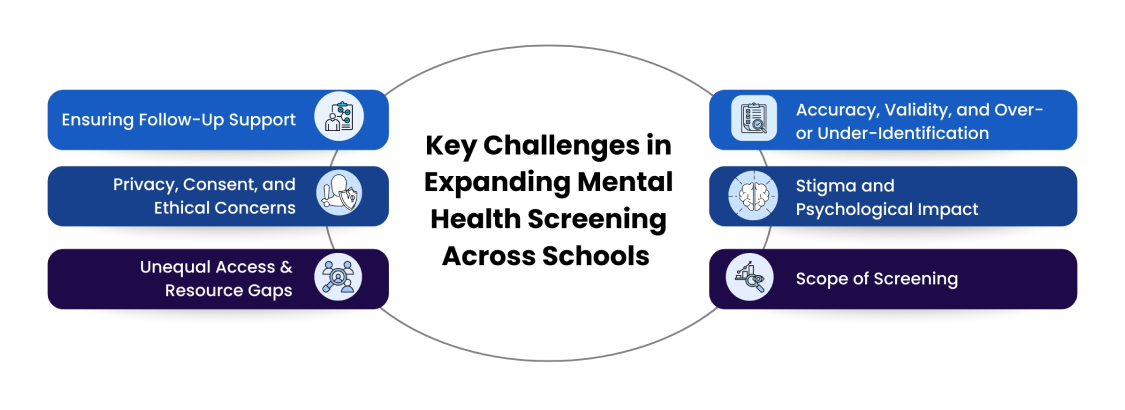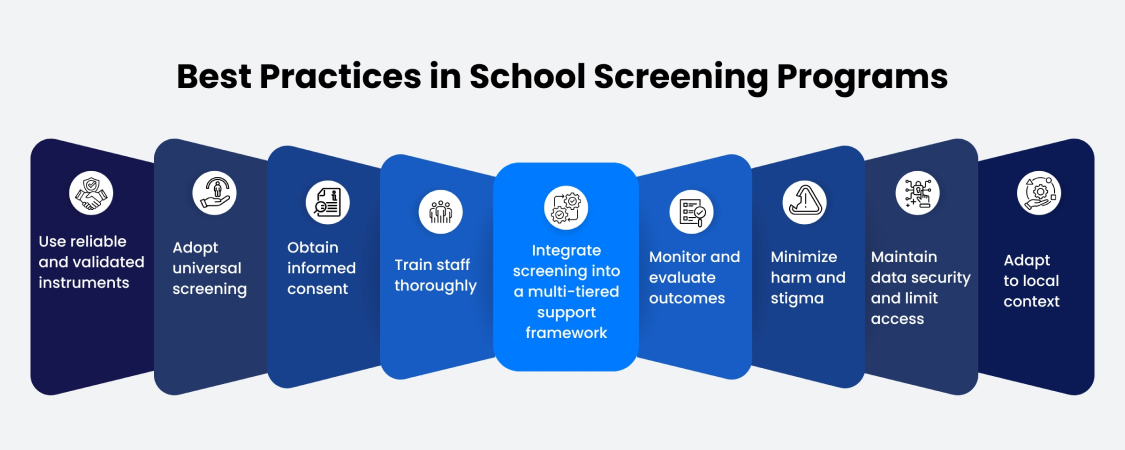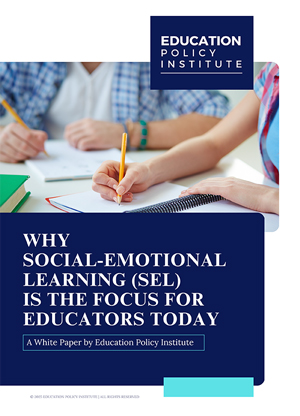In U.S. public K–12 schools, a notable shift is underway: mental health screening of students is becoming more common. What had once been an exception is now required in nearly one out of every three schools. This increase reflects growing recognition that student mental health must be addressed as part of a school’s duty of care. But the move also raises complex questions about implementation, follow-up, privacy, resources, and equity.
A Changing Landscape: Schools Where Screening Is Mandatory
Recent data show that about 30.5% of public K–12 schools now mandate mental health screening for students, especially for conditions such as depression and anxiety. In earlier years, only a small percentage of schools conducted screening systematically, for instance, in 2016, roughly 13% of districts reported doing so.
When schools screen and identify students showing signs of mental distress, many report notifying guardians, offering some in-person counseling, or referring to external mental health services. Yet even among schools that screen, a substantial share indicate difficulty in making sure that students receive the follow-up care they need. Some principals say matching identified students with providers is very hard. This evolving trend suggests that while the idea of mental health screening is gaining traction, putting it into practice involves steep hurdles.
Why the Push for Screening in Schools?
There are several drivers behind this growing movement:
-
Accessibility and Early Detection
Many students face barriers to accessing mental health services outside school like financial constraints, transportation, stigma, or lack of local providers. Schools offer a unique setting where students are already physically present, making it feasible to screen broadly and catch concerns early. -
Crisis and Stress as Catalysts
Surveys over the past few years have spotlighted youth mental health as a pressing issue, especially following social disruption and pandemic-related stresses. Anxiety, depression, and emotional distress have become more visible in younger populations, prompting calls for proactive mechanisms in everyday settings like schools. -
Preventive & Supportive Aim
The logic is that by identifying distress early, schools can intervene before challenges worsen mostly by providing counseling, skill-building, or connection to care. Screening is seen as part of a broader strategy of school mental health support rather than a standalone measure. -
Data to Inform Decisions
With systematic screening, schools can generate data about patterns of emotional or behavioral difficulties in their student bodies. That insight can help school leadership allocate resources, design wellness programs, or identify grade levels or groups with higher need.
Key Challenges in Expanding Mental Health Screening Across Schools
Although screening holds promise, several challenges require careful orientation.

-
Ensuring Follow-Up Support
Screening by itself is only useful if it leads to appropriate care. Many schools struggle to connect students flagged in screenings with sustained treatment or counseling. Lack of local mental health professionals, long waitlists, or funding limitations can block the next step. In fact, some schools lack the infrastructure to track whether a student actually accessed services after referral. -
Accuracy, Validity, and Over- or Under-Identification
Effective screening demands careful use of instruments that can distinguish between transient emotional stress and more serious conditions. False positives may lead to unnecessary anxiety, stigma, or resource strain, while false negatives may leave struggling students unsupported. Choosing psychometrically sound tools with sensitivity, specificity, and appropriateness for age groups is essential. -
Privacy, Consent, and Ethical Concerns
Screening involves sensitive personal information. Schools must navigate parental consent, student assent, confidentiality, and the rights of students and families. Transparency about how data will be used, who sees it, and how long it is stored is crucial. Students and guardians must feel safe and respected in the process. -
Stigma and Psychological Impact
Conversations about mental health can carry stigma. Students might fear being labeled or singled out. Some studies have found that the way screening questions are presented, including their frequency and order, can influence perceptions of stigma. Poorly managed screening may inadvertently worsen self-stigma or reluctance to seek help. -
Unequal Access & Resource Gaps
Schools vary widely in their resources. Some have established counseling staff or partnerships with mental health agencies. Others, especially in underfunded or rural districts, may lack staff or budgets. This uneven capacity can mean that students in some districts benefit from the screening system more than others. -
Scope of Screening
Not every mental health need is easily detected by questionnaires. Conditions such as substance misuse, trauma, or complex comorbidities may lie beyond the scope of standard screening tools. Screening must be part of a layered support system rather than a single measure.
Best Practices in School Screening Programs
For schools considering or refining screening, the literature and applied models suggest several principles to guide implementation:

- Use reliable and validated instruments: that are suited to the student age range and context.
- Adopt universal screening: meaning all students are screened rather than only those who appear to struggle; this reduces bias in selection and detection.
- Obtain informed consent: which is from guardians and assent from students, offering opt-out or opt-in modes, and clearly communicate purpose and data privacy.
- Train staff thoroughly: including teachers, counselors, and administrators, so they understand the purpose, limitations, referral pathways, and confidentiality.
- Integrate screening into a multi-tiered support framework: universal prevention, targeted interventions, and intensive services. Screening should connect seamlessly with other behavioral and mental health supports.
- Monitor and evaluate outcomes: track not just how many students screen positive, but how many access services, their outcomes, and whether the screening process itself changes over time.
- Minimize harm and stigma: design screening to be psychologically safe, consider question order and framing, allow students privacy, and provide preparatory orientation about emotional wellness.
- Maintain data security and limit access: ensure that student responses are stored securely, access is controlled, and anonymity is maintained wherever possible.
- Adapt to local context: rural vs. urban settings, availability of providers, cultural norms, and student demographics should influence the model chosen.
The Effects and Early Findings of Mental Health Screening in Schools
In some school districts, pilot implementations show promise. Screening data can reveal that a significant percentage of students report symptoms of anxiety, emotional distress, or social challenges. Interventions following screening have sometimes resulted in lower absenteeism, improvements in emotional regulation, or better student engagement when students receive early support.
However, longitudinal evidence on impacts (e.g. mental health trajectories, academic achievement, drop-out rates) is still emerging. Some studies suggest that merely introducing screening does not guarantee improved outcomes; the quality of follow-up care and integration into a broader mental health ecosystem matter critically.
The real test lies in whether screening leads to sustained engagement in care rather than one-off referrals. Schools that combine screening with on-site counseling, peer support, and community partnerships tend to see more consistent results.
Equity Considerations & Future Questions in Adopting Mental Health Screening in Schools
As screening gains ground, policymakers and educators must grapple with deeper questions.
-
Equity and Disparities
Will screening simply highlight schools that already have stronger mental health infrastructures? Students in under-resourced districts might get identified but lack access to treatment. This can compound inequality. Thought must be given to ensuring equitable service capacity across all districts. -
Transparency and Accountability
How will school systems report screening outcomes and should there be benchmarks or standards for rates of follow-up care are questions to keep in mind. Oversight mechanisms may be needed to prevent misuse of screening data or inequitable practices. -
Evolving Screening Tools & Technology
Advances in digital tools, passive data (such as activity metrics), or multimodal models (integrating voice, writing, or physiological signals) may enrich screening. Already, researchers are exploring machine learning systems that detect stress or risk from multimodal inputs. But deploying such systems in schools raises new concerns of privacy, algorithmic bias, and interpretability. -
Long-Term Research
There is a need for multi-year, large-scale studies to measure how screening affects mental health outcomes, academic success, retention, and school climate. Which models produce the best results, and what combination of screening, intervention, and follow-up is most effective, are yet to be found out. -
Cultural Sensitivity and Inclusivity
Screening must respect cultural norms around mental health, incorporate multilingual and inclusive instruments, and adjust for demographic variations in symptom expression. One size does not fit all. -
Costs and Sustainability
The financing of ongoing screening and follow-up services remains an important consideration. Grant funding may jumpstart initiatives, but sustainable models require stable budgets, staffing, and integration into school operations.
Conclusion
Bringing mental health screening into schools marks a significant evolution in how educational systems address student well-being. Requiring screening in almost one in three public schools signals a growing belief that social and emotional health must be part of the core mission of schooling.
Still, screening is not a stand-alone fix. Its value depends on quality instruments, robust referral networks, student trust, resource equity, and long-term commitment. When thoughtfully implemented, screening can catalyze earlier help, more informed decision-making, and stronger support for students. But without careful planning, it risks becoming a procedural checkbox rather than a meaningful tool.
As U.S. schools expand mental health screening, the coming years will reveal which models succeed, which fall short, and how this shift reshapes the role of schools in nurturing emotional as well as academic health.
Latest
Trends blogs
- Certification and Credentials: The New Fuel for Career Growth
- Technology in Outcome-Based Education: Driving Change in Higher Education
- Navigating AI in Higher Education: Possibilities and Concerns
- Shaping Tomorrow’s Educators: AI in Education and Institutional Growth





